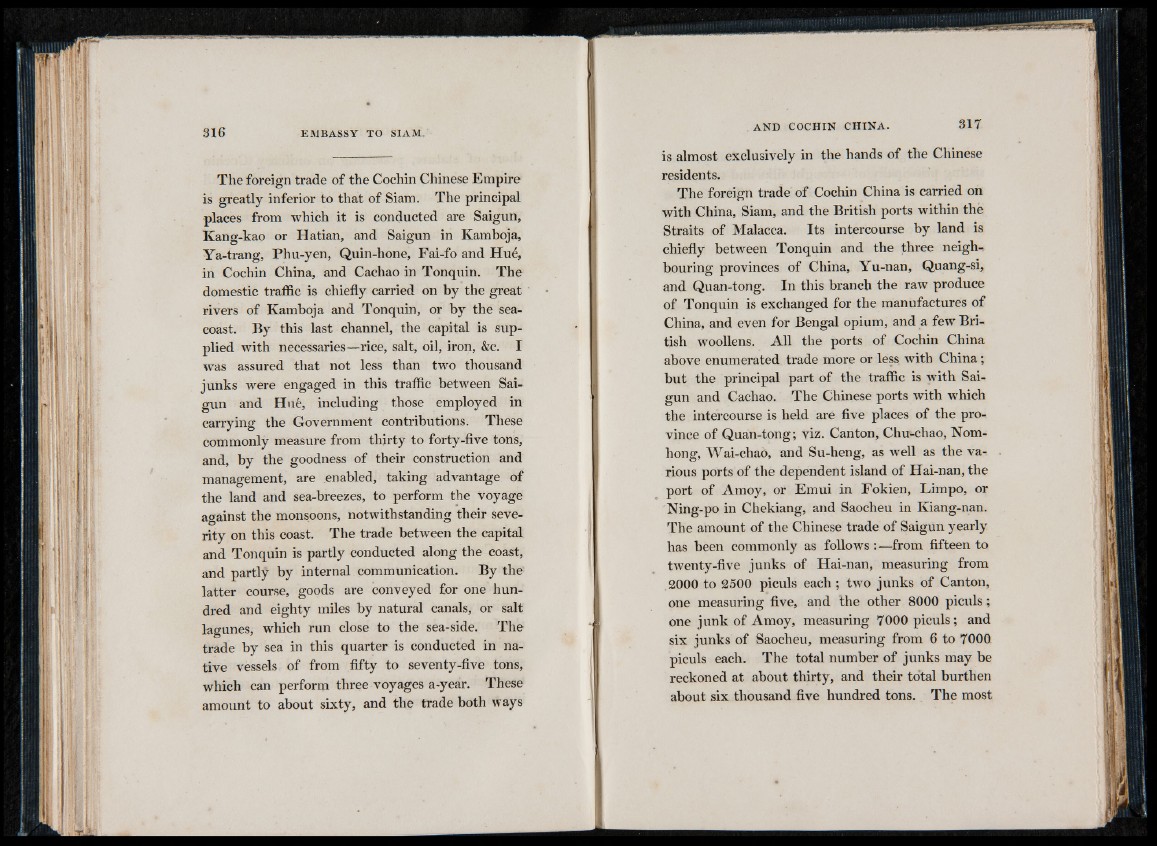
The foreign trade of the Cochin Chinese Empire
is greatly inferior to that of Siam. The principal
•places from which it is conducted are Saigun,
Kang-kao or Hatian, and Saigun in Kamboja,
Ya-trang, Phu-yen, Quin-hone, Fai-fo and Hué,
in Cochin China, and Cachao in Tonquin. The
domestic traffic is chiefly carried on by the great
rivers of Kamboja and Tonquin, or by the sea-
eoast. By this last channel, the capital is supplied
with necessaries—rice, salt, oil, iron, &c. I
was assured that not less than two thousand
junks were engaged in this traffic between Saigun
and Hué, including those employed in
carrying the Government contributions. These
commonly measure from thirty to forty-five tons,
and, by the goodness of their construction and
management, are enabled, taking advantage of
the land and sea-breezes, to perform the voyage
against the monsoons, notwithstanding their severity
on this coast. The trade between the capital
and Tonquin is partly conducted along the coast,
and partly by internal communication. By the
latter course, goods are conveyed for one hundred
and eighty miles by natural canals, or salt
lagunes, which run close to the sea-side. The
trade by sea in this quarter is conducted in native
vessels of from fifty to seventy-five tons,
which can perform three voyages a-year. These
amount to about sixty, and the trade both ways
is almost exclusively in the hands of the Chinese
residents.
The foreign trade of Cochin China is carried on
with China, Siam, and the British ports within the
Straits of Malacca. Its intercourse by land is
chiefly between Tonquin and the three neighbouring
provinces of China, Yu-nan, Quang-si,
and Quan-tong. In this branch the raw produce
of Tonquin is exchanged for the manufactures of
China, and even for Bengal opium, and a few British
woollens. All the ports of Cochin China
above enumerated trade more or less with China;
but the principal part of the traffic is with Saigun
and Cachao. The Chinese ports with which
the intercourse is held are five places of the province
of Quan-tong; viz. Canton, Chu-chao, Nom-
hong, Wai-chao, and Su-heng, as well as the various
ports of the dependent island of Hai-nan, the
port of Amoy, or Emui in Fokien, Limpo, or
Ning-po in Chekiang, and Saocheu in Kiang-nan.
The amount of the Chinese trade of Saigun yearly
has been commonly as follows :—from fifteen to
twenty-five junks of Hai-nan, measuring from
.2000 to 2500 piculs each ; two junks of Canton,
one measuring five, and the other 8000 piculs;
one junk of Amoy, measuring 7000 piculs; and
six junks of Saocheu, measuring from 6 to 7000
piculs each. The total number of junks may be
reckoned at about thirty, and their total burthen
about six thousand five hundred tons. The most